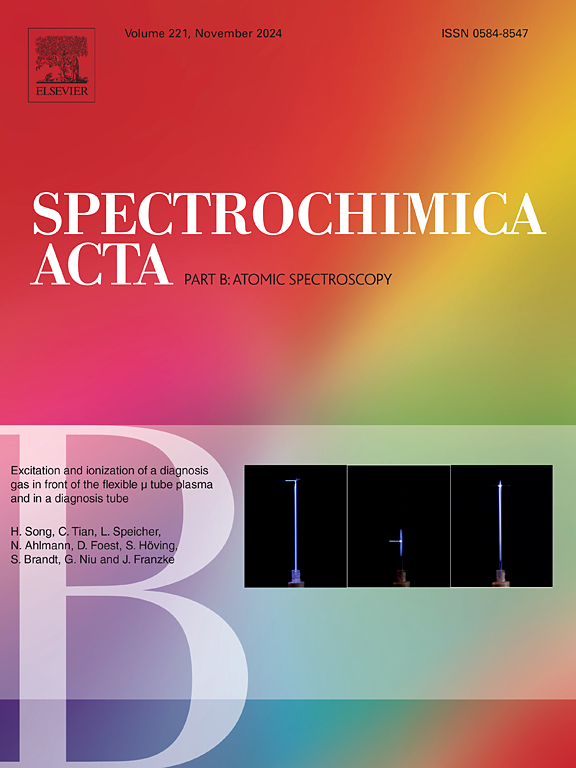激光诱导击穿光谱(LIBS)和拉曼光谱多阶矩融合用于矿物分类
IF 3.8
2区 化学
Q1 SPECTROSCOPY
引用次数: 0
摘要
传统的激光诱导击穿光谱(LIBS)方法主要依赖于光谱强度,忽略了嵌入在高阶矩特征(如均值、方差、偏度和峰度)中的丰富统计信息。这一限制阻碍了LIBS分析复杂矿物样品的准确性和普遍性。为了解决这一挑战,我们引入了一种提取和集成多阶矩特征的新方法,以增强谱表示并提高分类性能。具体来说,我们计算LIBS光谱的高阶统计矩,并使用Z-score归一化对其进行标准化,以消除维度偏差。然后使用随机森林模型来分配特征重要性权重,指导特征融合过程。所得的LIBS特征在特征级别与拉曼光谱数据进一步融合,允许每个样本的多参数表示。随后使用神经网络分类器来评估模型的性能。实验结果表明,该方法的分类准确率、精密度和特异性均超过99%,明显优于传统的基于libs的方法,后者的准确率仅为83.11%。这些发现突出了多阶矩融合在增强复杂样品光谱分析方面的有效性,并展示了其在矿物识别等领域的广泛应用潜力。本文章由计算机程序翻译,如有差异,请以英文原文为准。

Multi-order moment fusion of laser-induced breakdown spectroscopy (LIBS) and Raman spectroscopy for mineral classification
Traditional laser-induced breakdown spectroscopy (LIBS) methods rely primarily on spectral intensity, overlooking the rich statistical information embedded in higher-order moment features such as mean, variance, skewness, and kurtosis. This limitation hinders both the accuracy and generalizability of LIBS in analyzing complex mineral samples. To address this challenge, we introduce a novel approach that extracts and integrates multi-order moment features to enhance spectral representation and improve classification performance. Specifically, we compute higher-order statistical moments from LIBS spectra and standardize them using Z-score normalization to eliminate dimensional bias. A random forest model is then used to assign feature importance weights, guiding the feature fusion process. The resulting LIBS features are further fused at the feature level with Raman spectral data, allowing for multi-parameter representation of each sample. A neural network classifier is subsequently employed to evaluate the model's performance. Experimental results demonstrate that our fusion-based method achieves classification accuracy, precision, and specificity exceeding 99 %, significantly outperforming conventional LIBS-based approaches, which attain only 83.11 % accuracy. These findings highlight the effectiveness of multi-order moment fusion in enhancing spectral analysis of complex samples, and demonstrate its broad potential for applications in mineral identification and beyond.
求助全文
通过发布文献求助,成功后即可免费获取论文全文。
去求助
来源期刊
CiteScore
6.10
自引率
12.10%
发文量
173
审稿时长
81 days
期刊介绍:
Spectrochimica Acta Part B: Atomic Spectroscopy, is intended for the rapid publication of both original work and reviews in the following fields:
Atomic Emission (AES), Atomic Absorption (AAS) and Atomic Fluorescence (AFS) spectroscopy;
Mass Spectrometry (MS) for inorganic analysis covering Spark Source (SS-MS), Inductively Coupled Plasma (ICP-MS), Glow Discharge (GD-MS), and Secondary Ion Mass Spectrometry (SIMS).
Laser induced atomic spectroscopy for inorganic analysis, including non-linear optical laser spectroscopy, covering Laser Enhanced Ionization (LEI), Laser Induced Fluorescence (LIF), Resonance Ionization Spectroscopy (RIS) and Resonance Ionization Mass Spectrometry (RIMS); Laser Induced Breakdown Spectroscopy (LIBS); Cavity Ringdown Spectroscopy (CRDS), Laser Ablation Inductively Coupled Plasma Atomic Emission Spectroscopy (LA-ICP-AES) and Laser Ablation Inductively Coupled Plasma Mass Spectrometry (LA-ICP-MS).
X-ray spectrometry, X-ray Optics and Microanalysis, including X-ray fluorescence spectrometry (XRF) and related techniques, in particular Total-reflection X-ray Fluorescence Spectrometry (TXRF), and Synchrotron Radiation-excited Total reflection XRF (SR-TXRF).
Manuscripts dealing with (i) fundamentals, (ii) methodology development, (iii)instrumentation, and (iv) applications, can be submitted for publication.

 求助内容:
求助内容: 应助结果提醒方式:
应助结果提醒方式:


